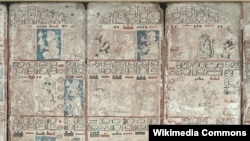Who remembers the Mayan Calendar that ended in 2012, and how it was supposed to presage the end of the world? That was funny, Hollywood made a movie about it.
Needless to say we're still here.
What was arguably lost in all of the sad speculation and fear-mongering of the end-of-the-world crowd was the sheer magnificence and depth of scientific knowledge that allowed the Mayans to create their giant stone calendars.
New research on an old book
The Mayans were an ancient and long-lived civilization that flourished in parts of present-day Central America. Their civilization lasted 2,000 years, but had its cultural heyday between 300 and 900 AD in an era archaeologists call "the Classic Period."
They developed a complex mathematical system based on the number 20. They had a symbol for the value of zero, a calendar-based agriculture system, an understanding of architecture, and a written language.
But the Mayans were masters of the sky, which they believed had a profound effect on their daily lives. They dutifully recorded all the things they saw in their stellar neighborhood. They predicted eclipses, and used their celestial calendars to manage planting seasons and their daily and religious lives.
But while most people are familiar with the giant round calendars, the Mayans also wrote books and filled them with information about their gods, and their lives and the movements of the stars in the sky.
One of the most famous books is the Dresden Codex, named for the museum of the Saxon State Library in Dresden, Germany, where you can see it on display. The codex consists of 39 double-sided pages of information in folded book form written on an ancient form of bark paper.
It's a beautiful document, and when completely folded out is almost 3.5 meters long. It consists almost entirely of astronomical information. But new research has just been released on one "chapter" of the codex called the Venus Table, which focuses on the closest planet to Earth and its movements.
The new paper was written by UC Santa Barbara's Gerardo Aldana, a professor of anthropology and of Chicana and Chicano studies, and is published in The Journal of Astronomy in Culture.
Why Venus?
The Mayans kept a particularly close eye on Venus because its movement was a marker for a number of their important economic and cultural events. To the Mayans, the role of Venus was similar to the Sun's solstice and equinox, which still mark some of our modern-day rituals. Venus was so important to the Mayans that researchers like archaeoastronomer Anthony Aveni from Colgate University has suggested that ancient cities like Uxmal were actually built to give their leaders good views of the morning star.
The movement of Venus was used to set the dates of Mayan cultural and economic rituals. That's why the codex devotes so much time to our sister planet.
Now this is where things get interesting... and really complicated.
Historians have known for over a century that the Venus table was unique in that it recorded a kind of "leap year" that 'fixed' or mathematically explained Venus' irregular movements across the sky. It's exactly like the 'leap year' in our calendars; and it's necessary because the movements of the earth and the observable planets aren't an exact match for our 24 hour day, and 365 day year.
The Venus Table is impressive because, using only their eyes and their understanding of math, the Mayans were able to both predict and record this weirdness in the orbit of Venus.
But Aldana says it is important to realize that Mayan astronomers weren't just counting the days it took Venus to cross the sky. He says that's just numerology, like counting down the days until your birthday.
But the Mayans did things based on the heavens. Using the birthday analogy, imagine if your birthday was based not on June 6 for instance, but instead on the location of Venus in the sky on the day you were born. In order to plan your party, you'd have to know when the planet would be back in your exact birthday position. That requires some really precise math that the Mayans did and recorded in the codex. The book is a comparison of past sighting and future predictions: "historical records rather than numerology," according to Aldana.
The codex basically let everyone know exactly when to throw their parties.
Aldana says Mayan astronomers were doing the same kind of science as Western giants of astronomy like Copernicus and Hipparchus. Copernicus discovered the earth revolved around the sun during his time as a church administrator when working to set the correct dates for Easter. He built upon astronomical observations dating back to the ancient Greeks, noted some irregularities and came up with the math that showed how the earth revolved around the sun.
Similarly, Aldana says the unnamed author of the Venus tables was working to set the dates for ritual events as important to the Maya as Easter to Christians. Using historical information about Venus' path through the heavens, this astronomer was trying to predict where it would be in the future. When the math didn't quite work, he fixed the problem and recorded his new predictions in the Venus tables.
"... based on a historical record ..." Aldana writes, this astronomer was actually "correcting" the record for the Mayan people.
Aldana says this shows us a moment in Mayan astronomy as important as Newton's discovery of gravity or Einstein's theory of relativity. This one astronomer lost to time changed the Mayan world, and wrote a book about it, saying in effect, "Hey look! I've fixed the Venus problem!"
The takeaway is another example that science, and those who are advancing it, stand on the shoulders of giants, who in many cases did their work using only a keen mind, and a keen eye.
Let’s be thankful they showed their work.










